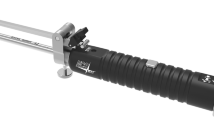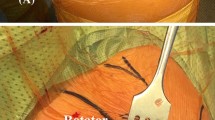Abstract
Background
Many surgical procedures have been reported for rotator cuff tears. We adopted the modified transosseous-equivalent procedure, also termed “surface-holding repair with transosseous sutures,” and demonstrated that this procedure has a biomechanical advantage regarding the concentration of stress on the tendon stump. This study aimed to evaluate the clinical and structural outcomes of this technique, which has been demonstrated by postoperative magnetic resonance imaging (MRI) to produce high intact rates.
Methods
Twenty-nine massive rotator cuff tears involving at least two tendons were treated by open repair using this procedure. Twenty-four patients were evaluated at an average of 43.2 months (range 24–71) postoperatively (the follow-up rate was 83.8%). The pre- and postoperative clinical outcomes were examined using the scoring system of the Japanese Orthopedic Association (JOA score). In an A-P radiograph, the presence of osteoarthritis (OA) of the glenohumeral joint and upward migration of the humeral head were compared pre- and postoperatively. The repair integrity of the cuff tendon was evaluated by applying Sugaya’s classification to the postoperative MRIs.
Results
The JOA score improved from 42.8 points preoperatively to 89.3 points at final follow-up. Radiographic examination showed that OA progressed in 16.7% and upward migration of the humeral head progressed in 20.8%. Postoperative MRI scans revealed 14 shoulders with type 1 repair based on Sugaya’s classification, 4 shoulders with type 2, 4 shoulders with type 3, 2 shoulders with type 4, and no shoulders with a type 5 repair.
Conclusions
Although osteoarthritis of the glenohumeral joint and upward migration of the humeral head had both progressed postoperatively in some cases, postoperative MRI scans revealed that 91.7% of the repairs resulted in a continuous rotator cuff. Therefore, this technique produces a high healing rate.


Similar content being viewed by others
References
Liu SH, Baker CL. Arthroscopically assisted rotator cuff repair: correlation of functional results with integrity of the cuff. Arthroscopy. 1994;10:54–60.
Worland RL, Arredondo J, Angles F, Lopez-Jimenez F. Repair of massive rotator cuff tear in patients older than 70 years. J Shoulder Elbow Surg. 1999;8:26–30.
Galatz LM, Ball CM, Teefey SA, Middleton WD, Yamaguchi K. The outcome and repair integrity of completely arthroscopically repaired large and massive rotator cuff tears. J Bone Joint Surg Am. 2004;86-A:219–24.
Gazielly DF, Gleyze P, Montagnon C. Functional and anatomical results after rotator cuff repair. Clin Orthop Relat Res. 1994;304:43–53.
Frank JB, ElAttrache NS, Dines JS, Blackburn A, Crues J, Tibone JE. Repair site integrity after arthroscopic transosseous-equivalent suture-bridge rotator cuff repair. Am J Sports Med. 2008;36:1496–503.
Gaenslen ES, Satterlee CC, Hinson GW. Magnetic resonance imaging for evaluation of failed repairs of the rotator cuff. J Bone Joint Surg Am. 1996;78:1391–6.
Motamedi AR, Urrea LH, Hancock RE, Hawkins RJ, Ho C. Accuracy of magnetic resonance imaging in determining the presence and size of recurrent rotator cuff tears. J Shoulder Elbow Surg. 2002;11:6–10.
Sugaya H, Maeda K, Matsuki K, Moriishi J. Repair integrity and functional outcome after arthroscopic double-row rotator cuff repair. A prospective study. J Bone Joint Surg. 2007;89:953–60.
Bigliani LU, McIlveen SJ, Cordasco F, Musso E. Operative repair of massive rotator cuff tears: long terms results. J Shoulder Elbow Surg. 1992;1:120–30.
Gerber C, Fuchs B, Hodler J. The results of repair massive tears of the rotator cuff. J Bone Joint Surg Am. 2000;82:505–15.
Harryman DT II, Mack LA, Wang KY, Jackins SE, Richardson ML, Matsen FA III. Repairs of rotator cuff Correlation of functional results with integrity of the cuff. J Bone Joint Surg Am. 1994;73A:982–9.
Oizumi N, Suenaga N, Fukuda K, Minami A. Massive rotator cuff tears repaired on top of humeral head by McLaughlin’s procedure. J Shoulder Elbow Surg. 2007;16:321–6.
Burkhead WZ, Skedros JG, O’Rourke PJ, Pierce WA, Pitts TC. A novel double-row rotator cuff repair exceeds strengths of conventional repairs. Clin Orthop Relat Res. 2007;461:106–13.
Kim DH, Elattrache NS, Tibone JE, Jun BJ, DeLaMora SN, Kvitne RS, Lee TQ. Biomechanical comparison of single-row versus double-row suture anchor technique for rotator cuff repair. Am J Sports Med. 2006;34(3):407–14.
Waltrip RL, Zheng N, Dugas JR. Rotator cuff tear repair. A biomechanical comparison of three techniques. Am J Sports Med. 2003;31:493–7.
Park MC, Cadet ER, Levine WN, Bigliani LU, Ahmad CS. Tendon-to-bone pressure distributions at a repaired rotator cuff footprint using anchor fixation technique. Am J Sports Med. 2005;33:1154–9.
Yamaguchi H, Suenaga N, Oizumi N, Miyoshi N, Hosokawa Y, Kanaya F. Comparison study of dual-row versus surface-holding repair technique—compression presser distribution of footprint. J Jpn Orthop Assoc. 2009;83(3):S501. (in Japanese).
Sano H, Yamashita T, Wakabayashi I, Itoi E. Stress distribution in the supuraspinatus tendon after tendon repair: suture anchors versus transosseous suture fixation. Am J Sports Med. 2007;35:542–6.
Funakoshi T, Suenaga N, Sano H, Oizumi N, Minami A. In vitro and finite element analysis of a novel rotator cuff fixation technique. J Shoulder Elbow Surg. 2008;17:986–92.
DeOrio JK, Cofield RH. Results of a second attempt at surgical repair of a failed initial rotator-cuff repair. J Bone Joint Surg Am. 1984;66:563–7.
Paavolainen P, Slatis P, Bjorkenheim JM. Transfer of the tuberculum majus for massive ruputures of the rotator cuff. In: Post M, Morrey B, Hawkins R, editors. Surgery of the shoulder. St Louis: Mosby; 1990. p. 252–6.
Gerber C. Latissimus dorsi transfer for the treatment of irreparable tears of the rotator cuff. Clin Orthop. 1992;275:152–60.
Liu J, Hughes RE, O’Driscoll SW, An KN. Biomechanical effect of medial advancement the supraspinatus tendon. A study in cadaver. J Bone Joint Surg. 1998;80:853–9.
Yamamoto N, Itoi E, Tuoheti Y, Seki N, Abe H, Minagawa H, Shimada Y, Okada K. Glenohumeral joint motion after medial shift of the attachment site of the sipraspinatus tendon: a cadaveric study. J Shoulder Elbow Surg. 2007;16:373–8.
Park MC, Tibone JE, Elattrache NS, Ahmad CS, Jun BJ, Lee TQ. Part II: Biomechanical assessment for a footprint-restoring transosseous-equivant rotator cuff repair technique compared with a double-row repair technique. J Shoulder Elbow Surg. 2007;16:469–76.
Midorikawa K, Hara M, Emoto G, Shibata Y, Naito M. Arthroscopic debridement for dialysis shoulders. Arthroscopy. 2001;17(7):685–93.
Rokito AD, Cuomo F, Gallagher MA, Zuckerman JD. Long-term functional outcome of repair of large and massive chronic tears of the rotator-cuff. J Bone Joint Surg. 1999;81:991–7.
Aoki M, Okamura K, Fukushima S, Takahashi T, Ogino T. Transfer of latissimus dorsi for irreparable rotator-cuff tears. J Bone Joint Surg. 1996;78B:761–6.
Matsuhashi T, Suenaga N, Oizumi N, Yamane S, Hisada Y, Minami A, Kasajima T. Infraspinatus/teres minor transfer for treatment of irreparable rotator cuff tears. Katakansetsu (The Shoulder Joint). 2007;31:569–73. (in Japanese).
Melillo AS, Savoie FH, Field LD. Massive rotator cuff tears: debridement versus repair. Orthop Clin North Am. 1997;28:117–24.
Conflict of interest
The authors did not receive and will not receive any benefits or funding from any commercial party related directly or indirectly to the subject of this article.
Author information
Authors and Affiliations
Corresponding author
About this article
Cite this article
Yamaguchi, H., Suenaga, N., Oizumi, N. et al. Open repair for massive rotator cuff tear with a modified transosseous-equivalent procedure: preliminary results at short-term follow-up. J Orthop Sci 16, 398–404 (2011). https://doi.org/10.1007/s00776-011-0092-9
Received:
Accepted:
Published:
Issue Date:
DOI: https://doi.org/10.1007/s00776-011-0092-9




